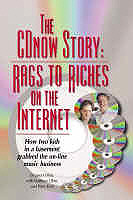Book review
The CDnow Story: Rags to Riches on the Internet, Jason Olim, with Matthew Olim and Peter Kent
Top Floor Publishing, 1999, ISBN 0966103262
Order directly
from the publisher or
from Amazon.com
 Reviewed
by Jean Hollis Weber
Reviewed
by Jean Hollis Weber
Jason and Matthew Olim founded CDnow, the most successful Internet music store, in 1994 -- a long time ago in the e-commerce world. This book tells of Jason's obsession with building a better music store (growing out of his frustration with trying to buy CDs from ordinary retail shops), and how his brother Matthew and various others joined him to make his dream a reality (CDnow employs around 200 people).
I quite enjoyed reading about the "early days" of e-commerce (four or five years ago!) and the solutions that the Olims found to the problems they encountered. The book is written from a very personal point of view, thus making it an easy and enjoyable read. It also includes a level of technical and business detail that should fascinate those readers who are interested in "how" as well as "what" the brothers did as they developed the store and the business (including distributors, marketing and promotions, raising venture capital, and other business issues).
The Olim brothers' story is interesting enough in itself, but of more relevance to technical editors are the points they make about electronic commerce. Even if you aren't personally running (or thinking of establishing) an internet business, your employer or some of your clients might be. Many people are putting their businesses on the net, often without having a clear idea of what they are attempting to achieve. Consequently, they are making some big mistakes, for reasons that the Olims discuss in some detail in this book.
Jason Olim keeps emphasising the point that a successful Internet based business is fundamentally different from a "real-world" based business. For example:
"Many companies were clearly very confused about what their Web sites are for, and how to make them achieve their purposes. Many companies were -- and still are -- trying to sell products online by providing a little information and an order form, but a Web site ... must be much more ... if it's to be really successful. Too many companies are focusing on the desired end product of the Web site without considering that in order to achieve its final purpose, whatever that may be, a Web site always has to do something else first -- it has to attract visitors."
"A Web store needs a huge number of visitors to be profitable, because most visitors won't buy anything... You need to get an awful lot of traffic if you want to make sales."
"...using modern technology, a business can ... treat each customer as an individual... If a large company doesn't understand the concept of one-to-one marketing, it probably can't compete on the Net... One-to-one marketing... allows you to target potential buyers very closely, presenting them with the offers that they're most likely to be interested in; and it creates a relationship between you and your buyers that makes it harder for them to leave and shop elsewhere... Internet businesses ... can provide more personal service than real-world ones."
And even when a business has a fairly good idea of the purpose of its Web site, and manages to attract visitors to the site, it often loses customers because they can't find the information they want, or the site loads too slowly, or something else in the design gets in the way.
The book makes the same point Peter Kent made in Poor Richard's Internet Marketing and Promotions -- a Web site is a piece of software, not graphic design.
"You can have all the information at your Web site, but unless your customers know where to find it, it's not very helpful."
"We were lucky when we began our Web site. At that point there wasn't a lot of information about Web design, so we didn't get distracted by the complete nonsense that all too often passes for advice in the Web-design world. We didn't set out to create a "cool" site, we tried to create a site that would provide the three important things that we believed our customers were looking for: selection, information and convenience... when a designer talks about making a Web site cool, it usually means adding pictures, using lots of neat little tricks to entertain visitors, using animations, adding sounds and so on."
"We feel the primary focus should be on function; once you've got the site to function the way you want it, then you can make it attractive. But to place form over function is a big mistake."
If you have any input into the content, presentation, design, or user interface of a Web site, it's worth reading this book and, if necessary, seriously encouraging higher-up decision makers to read it too. You may know the importance of these issue, but your boss or client might be inclined to pay more attention to the opinions of a couple of people running a very successful business.
Note: I don't have any association with Top Floor Publishing, though if you purchase any of Kent's books from Amazon.com through the links on my Web site, I'll get a commission -- just like any other site affiliated with Amazon.
If you can't find The CDnow Story in the shops, you can order it from Amazon.com.

